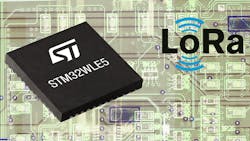SoC Forms Foundation of Smart Devices with LoRa IoT Connections
The STM32WLE5 SoC is touted by developer STMicroelectronics as the first LoRa system-on-chip (SoC) for connecting smart devices to the Internet of Things (IoT) using long-distance wireless connections. As a result, it opens the door for product developers to create devices such as remote environmental sensors, meters, trackers, and process controllers that help efficiently manage energy and resources.
The SoC combines ST’s ultra-low-power STM32 microcontroller design with a LoRa-compliant radio in one single-die and easy-to-use device. ST’s LoRaWAN software for wireless network communications has passed all regional certifications for use worldwide.
Available in a 5- × 5-mm UFBGA73 package, the STM32WLE5 is fully integrated into the STM32 ecosystem, including STM32Cube software support, as well as a LoRaWAN stack certified for all regions and available in source-code format.
The integrated radio, based on Semtech SX126x IP, is engineered with dual high- and low-power transmitter modes that cover the entire global sub-1-GHz unlicensed frequency range from 150 to 960 MHz, ensuring compatibility with LoRa networks in all territories. Hence, OEMs can use STM32WLE5 in all world markets, ensuring technical compatibility, and aiding operational efficiency and customer support. Sensitivity down to −148 dBm, and two embedded power amplifiers with up to 15 dBm and up to 22 dBm maximum transmit power available in the same package, maximize RF range.
In addition to the embedded LoRa modulation, the STM32WLE5 is also capable of (G)FSK, (G)MSK, and BPSK modulation, thus allowing for various alternative protocols including proprietary protocols. Moreover, high RF performance with low power consumption ensures reliable wireless connectivity and extends the runtime of battery-powered devices.
The microcontroller leverages ST’s STM32L4 architecture, which features the Arm Cortex-M4 core with DSP extensions. It also delivers ultra-low-power technologies including dynamic voltage scaling and ST’s adaptive real-time ART Accelerator for zero-wait execution from flash.
Generous 64-, 128-, and 256-kB flash options let developers choose the optimal code and data-storage density for the entire platform, including application and radio.
Users also benefit from the built-in cybersecurity features of STM32L4 microcontrollers, including hardware public key accelerator (PKA), true random-number generator (TRNG), sector protection against read/write operation (PCROP), and support for state-of-the-art cryptographic algorithms such as RSA.
STMicroelectronics, www.st.com/stm32wl

